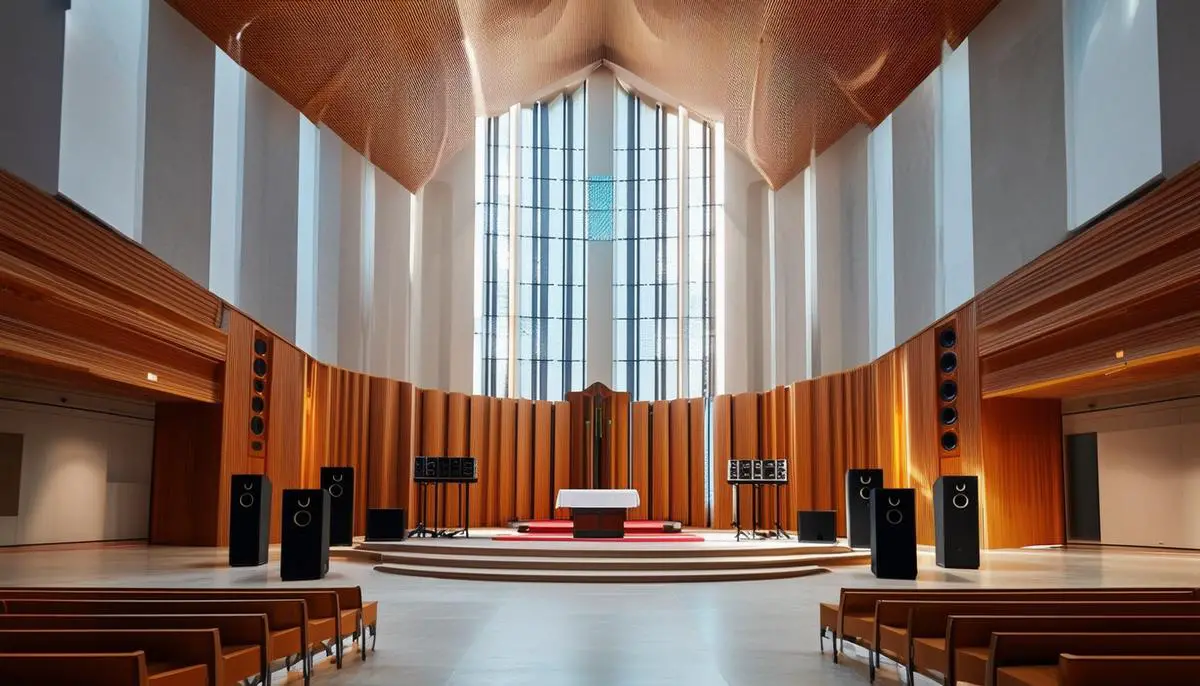Budget Church Sound Systems
1. Understanding Sound System Needs
When assessing their specific audio needs, churches should consider factors such as the size of the church, the type of services held, and the typical audience size. A larger church with a choir and band will need a more robust system compared to a smaller congregation that primarily holds spoken word services.
The architecture of the church also plays a role; buildings with high ceilings or many hard surfaces may require different acoustics solutions than more modern structures. Focus on scalability when defining your sound system needs, so the system can adapt to growing congregation sizes or changes in service style without requiring a complete overhaul. Modular systems that allow for gradual upgrades can be a cost-effective strategy, ensuring that improvements can be made as budget allows.

2. Cost Factors of Church Sound Systems
When choosing the right sound system for your church, it’s crucial to break down the cost. Many facets contribute to the overall financial commitment needed to install and maintain audio equipment suitable for worship environments. Equipment quality is a notable influencer in the budgeting equation. Higher quality speakers, microphones, and mixing consoles generally carry a higher price tag but offer better longevity and sound clarity. However, it’s important to strike a balance between quality and cost, especially under constrained budgets.
Installation intricacies can also dictate cost. The layout of the church, existing infrastructure, and necessary acoustic treatments impact the budget. In buildings with challenging acoustics or expansive areas to cover, professional installation might include additional acoustic modeling and equipment tuning. A more compact church may see reduced installation costs due to less intricacy and fewer equipment requirements.
Consider the hidden costs as well. Operating future upgrades, potential repairs, and regular maintenance also add to the lifetime expense of the sound system. Some systems might offer extensive aftersales support and warranties which, while possibly increasing initial expenses, can significantly decrease potential additional costs in the event of system issues post-installation. By fully understanding these elements, churches can make informed decisions that match their audio needs without compromising financial health.
3. The Role of Acoustics
Church acoustics play an essential role in the overall sound quality during services, influencing every decision from equipment selection to speaker placement. Each worship space carries its unique set of acoustic challenges; for instance, older churches often feature high ceilings and hard surfaces, which can cause sound to reverberate, blurring speech clarity and drowning out soft music tones. Newer constructions might have better insulation but could be too acoustically dead, sucking the life out of organ notes or choir voices.
Addressing these unique acoustical environments requires a thorough assessment, ideally by an acoustics expert who can evaluate the existing conditions using specific tests and measurements. This expert can offer insights into the need for sound-absorbing materials, diffusers, or perhaps even carpets and upholstered furniture, which can mitigate excess reverberation and enhance voice intelligibility.
Speaker placement is not just about where the wiring conveniently exists; it’s primarily about where sound can best fill the room without unpleasant echoes or dead spots. In more reverberant spaces, consider using more, strategically-directed speakers rather than a few powerful ones to evenly distribute sound across all seating areas. Directional audio technology, which sends sound waves in specific paths instead of all directions, can be effective in challenging acoustic scenarios.
The understanding and application of these acoustic principles allow for a greater experience during services and stretch the capability and efficiency of the investments made in sound system technology. Embracing specific tweaks for different use-cases, from choir rehearsals to community gatherings, allows for versatility and adaptability in how sound is managed in your sacred space.

4. Basic Components of Church Sound Systems
Understanding the core components of a sound system is essential for establishing a balanced and effective setup. Each element plays a vital role, and their proper integration can beautifully amplify the harmonious aspects of your church services.
Mixers are the heart of your sound system, where all audio signals converge. They allow you to control and adjust the volume, tone, and dynamics of audio sources, be it a pastor’s microphone, choir vocals, or instrumental music. Look for mixers with enough channels to accommodate all your inputs, considering potential future growth.
Microphones are essential for capturing clear and discernible audio. Wireless lapel mics work well for pastors, offering freedom of movement without compromising sound quality. Handheld mics can be perfect for guest speakers or for passing around during testimonials, while choir mics are designed to pick up sound from multiple directions.
Speakers are your sound system’s output and play a critical role in how well your congregation hears and experiences services. Depending on the size and acoustics of your church, you may need a range of speaker types including PA speakers and monitor speakers. Proper placement ensures optimal sound distribution, reducing dead spots and echo.
Amplifiers strengthen signals from the mixer to be loud enough for everyone in the room to hear through the speakers. While many modern speakers come with built-in amplifiers, known as powered speakers, you may opt for standalone amplifiers if you use passive speakers. Your choice depends on the existing components and the specific needs of your worship space.
Together, these tools craft a soundscape that elevates both the spoken word and musical praise components of your service. They advance not just sound, but synergy in your sacred gatherings, ensuring every message, note, and heartfelt expression reaches every ear in the assembly.
5. Church Sound Systems: Installation and Maintenance
Installing a church sound system involves a multifaceted approach to ensure that every sermon and song reaches every congregation member with clarity and impact. Here’s a glimpse into the professional installation process and some fundamental tips for maintaining your system efficiently:
Professional Installation Process
When it comes to installing a church sound system, the expertise of a professional is invaluable. The process generally involves:
- Site Survey and Acoustic Analysis: A professional installer assesses the architectural features, materials used in construction, and natural acoustics of the space to determine the strategic placement of components.
- System Design and Customization: Leveraging insights from the acoustic analysis, the installer designs a sound system tailored to your specific needs and space constraints.
- Installation and Calibration: This phase involves the physical setup of the system, followed by calibration to align the system’s output with the acoustics of the space.
- Training on Equipment Usage: Professional installers often provide training to church staff or volunteers on how to use the new equipment effectively.
Maintaining Your System Efficiently
To keep your sound system performing at its best, regular maintenance is essential:
- Regular Inspection Checks: Bi-monthly or quarterly checks can help catch issues before they turn into costly repairs.
- Software Updates and Backups: Keep any digital processors or mixer software updated to the latest version and back up settings regularly.
- Training Continuation: Keep your sound team sharp with regular training sessions.
- Environmental Care: Keep your equipment free from dust and avoid exposing it to extreme temperatures.
By adhering to these installation and maintenance essentials, your church can enjoy a sound system that captures and amplifies the soul and spirit of your services.

6. Budgeting for a Church Sound System
A sound financial plan for your church’s sound system starts with understanding how audio technology could serve both current and future congregational needs without overshadowing other fiscal responsibilities. Here’s how you can efficiently navigate budgeting for your church’s sound system:
- Assess Immediate and Long-term Needs: Identify what you require from a sound system immediately and consider future expansion plans to avoid redundant expenditures later.
- Set a Clear Financial Framework: Define a budget that acknowledges the church’s overall financial status, discerning between essential equipment and desirable upgrades.
- Opt for Multi-Functional, Upgradeable Equipment: Invest in technology that offers greater flexibility and scalability for better long-term value.
- Explore Various Funding Options: Consider special grants, fundraising events, or donations from supportive community businesses.
- Seek Professional Advice: Allocate part of your budget for consulting with an audio systems expert or an acoustician to ensure suitable equipment selection and setup.
- Consider Operational Costs: Factor in costs beyond the initial purchase, such as installations, maintenance, and potential repairs.
- Regular Review and Adjustments: Establish a periodic review of the technology in place and its usage to ensure your investment continues to match the requirements efficiently.
By creating a well-planned budget that considers both current use and future growth, you set your church on a path where every investment in audio technology is justifiable and productive, augmenting the ecclesiastical ambiance and community engagement without strain on the treasury.
7. Seeking Professional Advice For Church Sound Systems
In church sound systems, consulting with an audio professional can dramatically enhance the effectiveness of your investment. Here are scenarios where expert advice proves vital:
- Customized System Design: An audio professional can craft a customized sound system design that considers the unique acoustic challenges of your church space.
- Cost Efficiency: Audio professionals can help you select equipment that fits both your needs and budget, often suggesting solutions that provide better value for money.
- Avoiding Over or Under-Buying: An expert will help strike the right balance, ensuring you have just what you need without unnecessary extras or deficiencies.
- Integration with Existing Systems: If your church already has some audio components, a professional can advise on how to effectively integrate new equipment with the old.
- Navigating Technology Advances: An audio professional stays updated on trends and can guide you through upgrades that keep your system modern without unnecessary replacements.
- Training for Volunteers and Staff: Audio professionals can provide training sessions for your volunteers and staff, empowering them to manage and troubleshoot the system.
- Optimizing for Multiple Uses: An expert can set up a versatile system that can be easily modified to suit varying needs for different types of events.
- Regulatory Compliance and Safety: A professional installation ensures compliance with local regulations and safety considerations.
- Future-proofing: An expert can help you set up a solid foundation that’s easy to upgrade as technology progresses or as your church’s needs grow.
Engaging an audio professional assures you of reaching your goals efficiently, safely, and perhaps with some enjoyment along the way.
- Klepper, D. The acoustics of worship spaces. Acoust Today. 2011;7(3):34-41.
- Adelman-Larsen, NW. Efficient sound systems for churches and multi-purpose halls. Proceedings of Forum Acusticum; 2011; Aalborg, Denmark.
- Bradley, JS. Designing and assessing worship spaces. Sound & Video Contractor. 2019;37(6):46-52.













